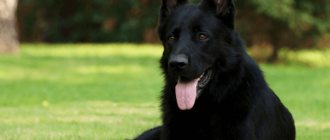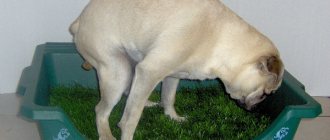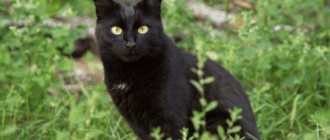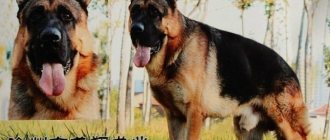Moskovok chickens belong to the meat-and-egg direction. The breed was bred relatively recently and is popular among breeders, as it has high taste and dietary qualities of meat and good egg production. The birds are easy to care for and attractive in appearance, resistant to diseases and have a balanced character. They can be grown both at home and for industrial purposes.
The birds' resistance to harsh climates allows them to be bred almost anywhere. Judging by the positive description of the breed of black Moscow chickens by poultry farmers, it is one of the most suitable for breeding in homestead farming. Chickens bring maximum benefit if the rules of keeping and care are followed.
Description of appearance
In 1980, a description of the breed was officially published under the name “Moscow Black”.
Breed characteristics:
- The body is elongated with powerful muscles.
- The comb is leaf-shaped, with graceful and well-defined teeth. Stands straight.
- The beak is black, curved, medium length.
- Eyes with orange or dark brown irises.
- The lobes can be white or red.
- The chest is lush and convex, the back is wide, straight, long.
- The length of the tail and wings is moderate. The tail is set low.
- The dominant color is black with a hint of green (see photo). The plumage is divided into 2 types. The first is chickens with golden necks, roosters with golden feathers on the back, lower back, and shoulders. The second type has a pronounced copper-red color. The chickens are predominantly black. The presence of white spots on the head and belly is allowed, but in adult birds the inclusions disappear.
- The legs are not feathered. Chickens are much darker than roosters. Pigmentation is clearly visible. A green tint is allowed.
- The plumage is abundantly dense, tightly fitting. Allows you to survive severe frosts.
Birds with a yellow beak and yellow legs are discarded and are not allowed to be bred.
A distinctive feature of the Moscow black breed of chickens, which poultry farmers confirm in their reviews, is their unpretentiousness to housing and feeding conditions, as well as resistance to diseases.
History of breeding
The Moscow black was bred at the Brattsevskaya poultry farm near Moscow and registered in 1980. The characteristics of the resulting chickens allow us to call them universal. The goal was to obtain an unpretentious bird with high egg production and delicious meat. The resistance of chickens to harsh climatic conditions, their ability to withstand even harsh winters, was also important.
The best breeds of chickens were used for breeding:
- New Hampshire;
- Yurlovskaya vociferous;
- Italian partridge (brown leghorn).
After this, the most viable hybrids were crossed with each other. As a result of this work, it was possible to obtain chickens with persistent traits, which turned from hybrids into a breed. Their breeding is possible at poultry farms and on private farms where it is not possible to maintain a large parent flock.
Breeders continue to work on improving the breed in order to further increase productivity while maintaining endurance.
Productivity
Moscow black has 2 lines, the characteristics of which are different:
- A more egg-like type - the body is lightweight, characterized by white lobes and golden inclusions in the plumage.
- The type is more meaty - the bird is more massive than the first, with red lobes and copper inserts in the plumage.
Moscow black chickens begin to lay eggs at 5-6 months. They lay eggs with light brown shells. Egg weight – 56-60 g. Oviposition begins in spring and ends in late autumn. With good care they can start laying eggs at 4 months.
The egg production of a truly purebred bird is 210-230 eggs. This figure is calculated based on the fact that for every 10 eggs 1.8-2 kg of feed is consumed. Therefore, the “productivity” of a laying hen largely depends on the diet.
When creating optimal conditions and providing balanced feed, egg production can be higher - up to 280 eggs per year. With insufficient nutrition, laying hens do not stop laying eggs, but the eggs become noticeably smaller and lose their marketable appearance.
The live weight of a one-year-old rooster is 2.5–3.3 kg, and that of a chicken is 2–2.5 kg. The bird produces quite a lot of meat, especially on the chest, and does not become overgrown with fat. The meat is considered tough. However, this mainly depends on the fact that excess males are used for it, which are kept for up to 7-8 months in order to select the most suitable sire. At the same time, the quality of meat is noticeably better than that of pure egg breeds.
Breeds with similar characteristics
The list of breeds with similar properties includes:
- Kuchinskaya. The birds were bred in the Moscow region. They quickly adapt to the climatic conditions of mid-latitudes, are resilient and weigh 3-4 kg. Egg production reaches 230-240 eggs per year.
- Zagorsk salmon. Breeders from Sergiev Posad worked on breeding the breed. Animals quickly gain weight, begin to lay eggs quickly and produce up to 180-200 eggs per year. They have a pronounced brooding instinct.
- May Day. The breed originated in Ukraine, but is popular in Russia. The advantages of the breed include resistance to adverse weather and egg production of 200 eggs per year. Young individuals are hardy and easy to care for.
Pervomayskaya breed of chickens.
Advantages and disadvantages
The Moscow Black chicken breed is liked by poultry farmers and farmers due to many advantages:
- Unpretentious to feed.
- Suitable for cage keeping.
- They tolerate severe frosts well even in an unheated poultry house.
- Resistant to diseases.
- With industrial breeding, the mortality rate is low.
- They are not shy and easily tolerate transportation. Stress-resistant, which is especially important for laying hens.
- Good egg production rates.
- Large carcass sizes.
- Chick survival rate is almost 100%.
Disadvantages include a low brooding instinct. However, quite a lot of farmers consider these chickens to be good hens and mothers.
Advantages and disadvantages of Moscow black
Like any living beings, chicken representatives have their strengths and weaknesses. Black chickens have a lot of advantages. The main ones:
- Lasting immunity.
- Endurance.
- Stress resistance.
- Completely not picky about the diet.
- Resilience.
- Calm disposition.
- Exceptional egg production.
- Incredibly tasty meat.
With all its splendor, the bird has a number of disadvantages, which, however, are not so terrible against the background of its positive qualities:
- weak instincts for incubating offspring;
- delayed puberty;
- risk of obesity with excess diet.
Breeding
The Moscow breed of chickens, according to the description, is characterized by a weak brooding instinct and that hens are in no hurry to sit in hens. On the one hand, this is a minus, since chickens have to be hatched either in incubators or with the help of a chicken of a different breed. On the other hand, there is a plus - egg production increases. Nevertheless, many poultry farmers say that this species tends to sit on eggs even in winter.
Eggs for incubation are taken from chickens that have reached the age of 10-12 months. Egg fertilization is 100%. The safety of the young animals is good. Out of 100 hatched chickens, no more than 5 die. The chicks have good immunity.
Beginning poultry farmers are recommended to buy eggs from trusted producers for the first hatch in order to get purebred chickens and not be disappointed. Then you can breed it yourself.
The peculiarity of the breed is that the sex of the chickens can be distinguished at the age of 1.5 months, which is important to consider when purchasing.
Practical advice
By feeding
You should not overfeed Moscow black breed chickens, because their phlegmatic character, combined with a good appetite, can lead to obesity.
It is a mistake to use only compound feed without including other food. It is not difficult to prepare feed from a mixture of grain crops, give the livestock wet mash with bran, boil potatoes, introduce premixes and fish oil into the diet.
The livestock eats greens and grated vegetables and will not refuse silage in winter. Insects and larvae serve as a source of protein food in summer. When cold weather sets in, they compensate for the protein deficiency with pieces of meat.
It is advisable to feed grain at night, during the formation of eggs, when the bird’s body releases high energy costs and therefore needs increased nutrition.
By content and rejection
Maintaining the Moscow black breed is impossible without culling defective young animals in order to prevent degeneration of the livestock.
Healthy chickens that meet the standard will help maintain the purity of the breed and achieve high productivity returns.
Chickens with sagging bellies and wings, incorrect positioning of legs, and a violation of the structure of the body are subject to culling.
Roosters with sunken chests, developmental delays, and whitish earrings and combs are not suitable as breeders.
It is also recommended to keep the house clean, regularly ventilate, and change the litter to prevent dampness. Periodically wash and disinfect drinking bowls and feeders, and inspect chickens for the presence of parasites.
Purchasing chickens
It is a mistake to purchase a population of black Moscow chickens on the market from unverified sellers. Young animals may not correspond to the breed or may introduce dangerous diseases into the farmyard.
It is recommended to contact breeders who can demonstrate veterinary certificates about the health of the livestock. The chicks are first placed in a separate cage away from the yard to allow them to get used to their new environment and feeding, and to ensure that they are healthy.
Content
According to most farmers, Moscow black chicken is most suitable for Russian climatic conditions. An adult bird tolerates frost well and can winter in an unheated chicken coop. At a temperature of -30 degrees, roosters may experience frostbite on their combs. Poultry farmers do not note any more serious consequences. In a warm poultry house, where the temperature does not drop below 0 degrees, they are able to lay eggs in winter.
The nature of chickens is peaceful. And this despite the fact that there is blood from the Yurlov breed, known for its fighting, quarrelsome disposition. Moscow black chickens are very active, fidgety, poultry farmers call them “savages”. Adults are calm, even tame birds, they get used to their owner and are not shy. If there are bullies of other breeds on the farm, it is better to keep them separately.
The Moscow Black feels equally good when kept indoors or on a walk.
In any case, it is important for birds to arrange baths with sand or ash. Baths are needed to get rid of external parasites. Representatives of the breed are quite “flying”. Therefore, if necessary, they do a manicure - trim one wing so that the bird does not fly over the fence.
How to keep and what to feed
Primary requirements
The Moscow Black breed chicken is genetically adapted to being kept at sub-zero temperatures. Without heating, the bird can withstand -30 °C, although it continues to lay eggs at temperatures not lower than 0 °C. It is recommended to release livestock for walking at temperatures not lower than -20 °C to avoid frostbite.
The Moscow chicken breed is tolerant of cage and floor housing in the poultry house. The room should be spacious and illuminated by sunlight. In winter, infrared lamps are installed above the perches for heating.
In summer, the litter is regularly changed to prevent the proliferation of harmful microorganisms. In winter, it is enough to replace it once every two months by adding a dry layer of sawdust or straw on top. The litter absorbs excess moisture and maintains temperature conditions.
Ventilation or windows are installed in the poultry house to prevent the livestock from being poisoned by ammonia fumes.
Walking rules
To maintain the health of the livestock, a paddock near the poultry house is fenced off so that the birds search for pasture.
On the walking area there are baths filled with sand and ash, where chickens can get rid of skin and feather parasites.
They also take care of protection from the sun's rays in the form of sheets of plywood to protect the laying hens from overheating on a summer afternoon.
Diet
Moscow black chickens will not die from unbalanced feeding, but will not show productive qualities. Birds need to allocate more feed than for egg crosses, but less than for meat chickens.
Rational nutrition consists of:
- grain crops such as corn, oats, wheat, barley;
- wet mash with skim milk, meat or fish broth;
- raw and boiled vegetables and root vegetables, fruit carrion;
- crushed coal, shells, chalk, sand or screenings.
When kept without walking, earthworms or meat trimmings are introduced into the chickens' diet.
In summer, the birds are given dried herbs and nettles. For the winter, brooms are prepared from pine paws to provide them with vitamins. In cold weather, juicy root vegetables are fed in equal parts with grains.
Nuances of feeding
It is not recommended to overfeed Moscow black chickens with corn and boiled potatoes in order to avoid obesity of internal organs. This can lead to the death of livestock.
In summer, chickens are fed twice a day; in winter, food must be supplied in three stages.
Be sure to have clean water in drinking bowls. If food poisoning is suspected, potassium permanganate is added until the water turns light pink.
Feeding chicks and adult chickens
The first food for hatched chicks is a crushed boiled egg. On day 3, the brood begins to be fed with boiled millet, cottage cheese, and green onions. At the age of 1 month, chickens are transferred to grain feed.
Adult chickens are absolutely unpretentious in food. They eat everything they give. In winter, instead of water, they peck snow beautifully.
Expert opinion from the site My Chicken Coop
Maria Nikolaevna
Experienced poultry farmer, 35 years of experience
Ask a Question
For feeding, a ground grain mixture is used, mainly from wheat, barley, corn (depending on the region). You can feed boiled potatoes and whole grains. The diet must include green grass and fresh vegetables. Additionally, chalk, fish oil and other feed additives are given.
Feeding a bird well does not mean making it obese. It is important to monitor the calorie content of the feed and, if necessary, reduce it by adding bran.
Diet
In order for chickens to lay many eggs, they need to be fed properly. Their diet should be balanced and necessarily include the following products:
- Squirrels. Chickens need proteins to form eggs and quickly gain weight. A large amount of proteins is found in legumes, rice, mash, etc.
- Vitamins and beneficial microelements. Experts advise giving the bird fish oil, yeast, and plenty of fresh grass.
- Minerals. It is very important to provide chickens with the necessary amount of minerals. Thanks to them, the crusts form a strong backbone and a strong eggshell. Sources of minerals include: chalk, crushed eggshells, crushed shell rock. Of all the sources described above, crushed shell rock is best suited. In the case of crushed eggshells, you need to be extremely careful, because if the hen recognizes an egg in the shell, she may begin to peck at the laid eggs and it will be very difficult to wean her from this habit. As for chalk, this is the worst option, since if chalk is used frequently, it can stick together and cause clogging of the gastrointestinal tract.
- Carbohydrates. The activity and endurance of the bird depends on the amount of carbohydrates. Chickens get most of their carbohydrates from grains and vegetables.
Feed the bird 3 times a day. It is advisable to give grains in the morning and evening, but mash is ideal for lunch.
In addition to food, chickens should always have access to clean water. In summer it is changed 2 times a day, in winter 1 time a day.
Since chickens very often swarm around in water and feeders, special nets are installed on containers with food and water that do not block access to water and feed, but at the same time protect the contents from feces and scattering.











